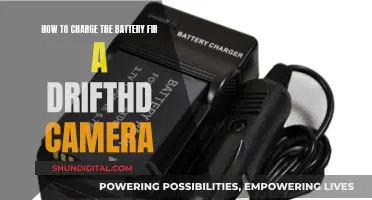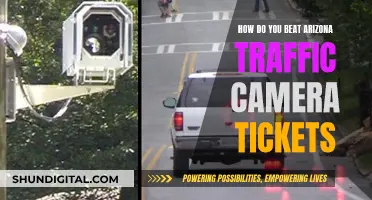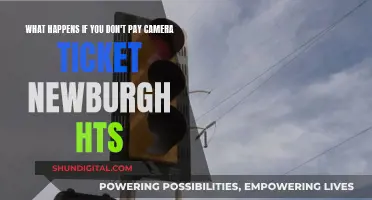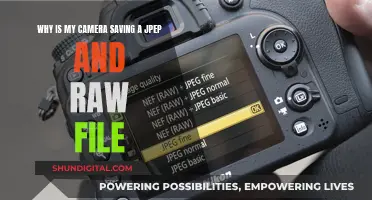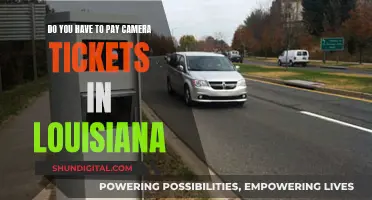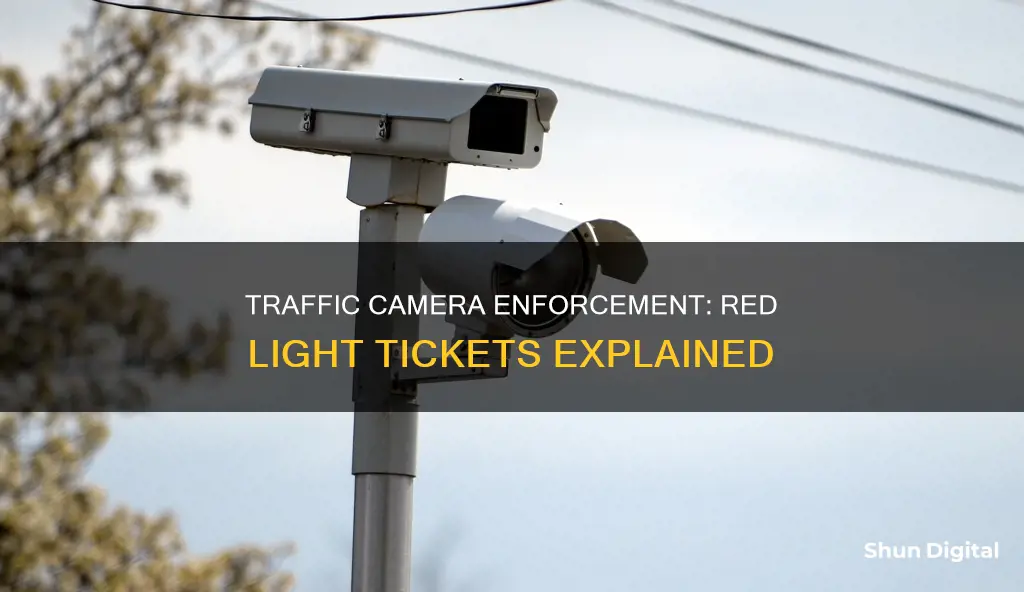
Red light cameras are an effective way to enforce traffic laws and improve road safety. They are designed to capture images or videos of vehicles that run red lights, and are typically installed at busy intersections to target frequent violations. When a vehicle crosses the limit line or enters the crosswalk on a red light, sensors trigger the camera to take photos or videos, which are then reviewed by authorities to issue tickets. While these cameras improve safety and reduce accidents, their use varies across states due to legal and privacy concerns, with some states prohibiting certain types of recordings. Understanding how these cameras work and their locations can help drivers avoid violations and stay safe on the road.
| Characteristics | Values |
|---|---|
| Who is responsible for the ticket? | The owner of the car |
| Who reviews the images? | The Department of Transportation (DOT) |
| What happens after the review? | Notices of liability are mailed to vehicle owners |
| What is included in the notice of liability? | Date and time of violation, elapsed time from when the light turned red, street lane that triggered the camera, photo sequence, and cost of the ticket |
| What happens if the fine is not paid? | A $25 penalty is added to the fine |
| What is the purpose of red light cameras? | To capture violators without any manual work |
| What are the three elements used by law enforcement? | Cameras, computers, and triggers |
| What triggers the camera? | Sensors in the pavement |
| What does the camera capture? | Still shots and a video of the driver going through the light |
| What happens after the camera is triggered? | A traffic ticket is mailed to the registered owner of the vehicle |
What You'll Learn

How red-light cameras work
Red-light cameras are automated enforcement systems that law enforcement uses to monitor intersections. They are synchronised with traffic signals and catch drivers who fail to stop when the light is red.
Red-light camera systems are typically made up of three components: the signal (traffic light), cameras, and pavement sensors. The cameras are positioned at the corners of an intersection, often on poles a few yards high, and point inwards to photograph cars driving through the intersection from different angles. The cameras are triggered by sensors in the pavement, which detect vehicles approaching the intersection and estimate their speed. If a vehicle is estimated to be going too fast to stop when the light is red, the camera is triggered, taking still shots and a video of the driver going through the light.
The footage from red-light cameras is then reviewed by a technician or officer, who decides whether to issue a citation. If a citation is issued, the registered owner of the vehicle will receive a ticket in the mail, including photographs of the violation and instructions for paying the fine or appearing in court.
Lithium Batteries in Disposable Cameras: What's the Deal?
You may want to see also

How to spot a red-light camera
Red-light cameras are a type of traffic enforcement camera that photographs vehicles that enter an intersection after the traffic signal has turned red. They are used in over 75 countries worldwide, including the US, the UK, China, and Australia.
- They are usually located near busy intersections.
- They are often mounted on tall silver or white metal poles close to the signal.
- They are sometimes attached to streetlight poles that are positioned correctly.
- They come in different sizes and designs, including large square silver or white boxes with the flash installed beneath, and rectangular boxes that resemble surveillance cameras.
- Some cities post warning signs when a red-light camera is present.
- Some locations have extra red lines painted on the road to indicate a violation.
- There are usually signs posted about 50 to 500 feet from the signal where the camera is installed.
HDR Camera Mode: Unlocking the iPad's Hidden Potential
You may want to see also

What happens when you get caught
Red light cameras are becoming increasingly common, and they can be a source of concern for drivers. So, what happens when you get caught by one?
Firstly, it's important to understand how these cameras work. Red light cameras are typically triggered by sensors installed in the road. When a vehicle passes over the stop line on a red light, the sensors activate the camera, which captures an image of the vehicle's license plate and, in some cases, the driver. These cameras are usually positioned at intersections or traffic lights, and you may see a flash when the camera is activated.
If you are caught by a red light camera, you will typically receive a ticket or notice of violation in the mail. This usually includes details such as the date, time, and location of the violation, as well as images or video evidence of the incident. The ticket will be sent to the registered owner of the vehicle, regardless of who was driving. In some cases, you may be able to view the evidence online by logging on to a website provided on the notice.
The process for handling a red light camera ticket can vary depending on the state or local regulations. In some cases, the ticket may need to be reviewed and approved by a commissioned officer before it is issued. Once you receive the ticket, you will usually have a time limit to pay the fine or challenge the ticket. The amount of the fine can vary, but it can range from $50 to $500 or more. It's important to note that unpaid violations may be sent to collections or result in additional penalties.
If you were not the driver at the time of the incident, you may have the option to provide the name of the driver, but this is not always obligatory. In some states, you may be able to contest the ticket if you have a valid reason for running the red light, such as a health emergency or following the instructions of law enforcement. However, these tickets can be difficult to fight, and it may be a better option to consider a plea bargain or taking an online driving course to dismiss the infraction from your record.
Overall, getting caught by a red light camera can result in a fine and potential consequences for your driving record. It is important to be aware of the regulations in your area and to drive safely to avoid these types of violations.
Charging 1080p Camera Batteries: A Step-by-Step Guide
You may want to see also

How to find out if you got a ticket
If you're concerned that you may have been caught running a red light by a traffic camera, there are a few ways to find out if you've received a ticket. The process may vary depending on your location, but here are some general steps you can take:
Check Online
In some places, you can check for tickets online. For example, in Seattle, you can view pictures and videos of alleged camera violations on www.violationinfo.com using the citation number and PIN provided on the Notice of Infraction that was mailed to you. Similarly, in Florida, you can enter your driver's license number on the License Check website provided by the Florida DMV to check for any red light tickets. A quick internet search for your local area may help you find the correct website for checking traffic tickets.
Contact the Local Courthouse
If you can't find the information online, you can try contacting the local courthouse. In Florida, each county courthouse enforces red light violations, so you can call them to inquire about any violations. However, if you've travelled across multiple counties or states, you may need to contact multiple courthouses.
Check Your Mail
In many cases, red-light camera tickets are mailed to the registered owner of the vehicle. These violation notices typically include the date, time, and location of the violation, as well as photographs and information on how to view the video footage. However, the mail can be unreliable, especially if you've recently moved, so it's a good idea to use other methods to check as well.
Look Out for Warning Signs
In some cities, there may be warning signs posted when a red light camera is in use at a particular intersection. Keep an eye out for these signs, as they can help you determine whether you're likely to receive a ticket.
Check for Flashes
When a red-light camera takes a photo, you may notice one or several camera flashes. While this isn't always noticeable, it can be an indication that you've been caught running a red light. However, newer cameras may use an infrared flash that is harder to see.
Remember, the specific process for checking traffic tickets may vary depending on your location, so it's always a good idea to check the official sources or websites for your local area.
Understanding Camera Settings: Raw Buffer Size Explained
You may want to see also

What to do if you get a ticket
If you've received a red light camera ticket, the first thing to do is to check the ticket for details of the incident, including the date, time, and location, as well as instructions on how to pay the fine or contest the ticket. You should also check your schedule to confirm if you were driving at the time of the incident.
Red light camera tickets are usually sent to the registered owner of the vehicle, regardless of who was driving. If you weren't the driver, you can submit an affidavit swearing that you were not driving when the violation occurred, and the ticket will likely be dismissed.
If you were driving, you can request photographs or videos of the incident, which are often available online or from the relevant law enforcement agency. Review the footage and traffic laws, and examine the intersection where the incident occurred to ensure that the traffic light, camera, and warning signs were all in working order.
You can also check if there are any specific defences allowed in your state, such as being able to prove that you drove through the red light due to a health or emergency situation, or because you were following the instructions of law enforcement personnel.
If you decide to contest the ticket, you will need to enter a plea of "not guilty" and present your case in court, providing any physical evidence and witness testimonies to support your defence.
Speeding Camera Tickets: Ignoring Fines, Facing Consequences
You may want to see also
Frequently asked questions
Traffic cameras are triggered by sensors that detect when a vehicle passes over a crosswalk line on a red light. They then take a photo of the license plate and the driver.
You will usually notice one or several camera flashes when the camera is taking a photo. You will then receive a ticket in the mail, which will include the photo evidence, citation, and amount to pay.
You will need to decide whether to pay the fee or challenge the ticket. In some cases, you may be able to lower or dismiss the fine.
In addition to a fine, you may also receive points on your driving record. In some states, this can lead to a license suspension. Running a red light can also result in a reckless driving conviction or, in the worst case, a vehicular manslaughter charge if someone is killed.


